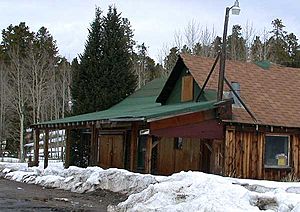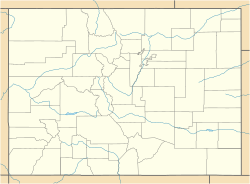Gould, Colorado facts for kids
Quick facts for kids
Gould
|
|
|---|---|

General store along State Highway 14 in Gould, April 2005
|
|
| Etymology: Edward Bradley Gould | |
| Country | United States |
| State | Colorado |
| County | Jackson County |
Gould is a small community in Jackson County, Colorado, United States. It's called an "unincorporated community" because it doesn't have its own local government like a city or town. Instead, it's managed by the county.
Contents
What is Gould Like?
Gould is located in a beautiful area called North Park. You can find it along State Highway 14, southeast of Walden. The community sits in a valley between Owl Mountain and Gould Mountain.
The land around Gould is a mix of different natural areas. You'll see wet areas, thick pine forests, groves of aspen trees, and sagebrush plants. It's a great place for nature lovers!
Businesses and Attractions in Gould
Even though it's small, Gould has a few places for people to visit. There's a tavern, places to camp, and a community center. Several other businesses serve the people who live there and visitors.
One of the most popular spots is the Colorado State Forest Headquarters. It also has the Moose Visitor Center, where you can learn about the local wildlife. Gould is located at an elevation of about 8,913 feet (2,717 meters) above sea level.
Who is Gould Named After?
The community of Gould got its name from Edward Bradley Gould, who was a cattleman. A post office was open in Gould from 1937 until 1973. Currently, Luke Jones is the Mayor of Gould. A mayor is a leader who helps manage the community.
What is the Climate Like in Gould?
Gould has a subarctic climate. This means it has long, cold winters and short, cool summers. It's a type of climate often found in northern regions or at high elevations.
The table below shows detailed weather information for Gould. It includes average temperatures, how much rain or snow falls, and record high and low temperatures.
| Climate data for Gould, Colorado, 1991–2020 normals: 9000ft (2743m) | |||||||||||||
|---|---|---|---|---|---|---|---|---|---|---|---|---|---|
| Month | Jan | Feb | Mar | Apr | May | Jun | Jul | Aug | Sep | Oct | Nov | Dec | Year |
| Record high °F (°C) | 54 (12) |
56 (13) |
60 (16) |
70 (21) |
77 (25) |
19 (−7) |
27 (−3) |
24 (−4) |
12 (−11) |
−14 (−26) |
−24 (−31) |
−31 (−35) |
77 (25) |
| Mean maximum °F (°C) | 46.7 (8.2) |
47.0 (8.3) |
53.1 (11.7) |
61.0 (16.1) |
71.0 (21.7) |
78.3 (25.7) |
81.7 (27.6) |
79.6 (26.4) |
75.6 (24.2) |
66.7 (19.3) |
55.1 (12.8) |
46.3 (7.9) |
82.1 (27.8) |
| Mean daily maximum °F (°C) | 29.0 (−1.7) |
30.4 (−0.9) |
38.0 (3.3) |
45.0 (7.2) |
54.8 (12.7) |
66.8 (19.3) |
72.9 (22.7) |
71.6 (22.0) |
64.3 (17.9) |
50.5 (10.3) |
37.9 (3.3) |
30.0 (−1.1) |
49.3 (9.6) |
| Daily mean °F (°C) | 15.8 (−9.0) |
17.5 (−8.1) |
25.0 (−3.9) |
32.3 (0.2) |
40.9 (4.9) |
50.2 (10.1) |
56.3 (13.5) |
54.8 (12.7) |
47.7 (8.7) |
36.1 (2.3) |
24.9 (−3.9) |
17.0 (−8.3) |
34.9 (1.6) |
| Mean daily minimum °F (°C) | 2.7 (−16.3) |
4.6 (−15.2) |
12.0 (−11.1) |
19.6 (−6.9) |
27.1 (−2.7) |
33.5 (0.8) |
39.7 (4.3) |
38.0 (3.3) |
31.1 (−0.5) |
21.7 (−5.7) |
11.9 (−11.2) |
3.9 (−15.6) |
20.5 (−6.4) |
| Mean minimum °F (°C) | −22.1 (−30.1) |
−20.6 (−29.2) |
−10.8 (−23.8) |
0.2 (−17.7) |
13.2 (−10.4) |
23.5 (−4.7) |
31.7 (−0.2) |
29.8 (−1.2) |
19.7 (−6.8) |
4.0 (−15.6) |
−10.0 (−23.3) |
−21.0 (−29.4) |
−27.0 (−32.8) |
| Record low °F (°C) | −35 (−37) |
−46 (−43) |
−30 (−34) |
−15 (−26) |
−1 (−18) |
— | — | — | — | — | — | — | −46 (−43) |
| Average precipitation inches (mm) | 1.72 (44) |
2.53 (64) |
1.84 (47) |
2.65 (67) |
2.30 (58) |
1.66 (42) |
2.35 (60) |
2.07 (53) |
1.89 (48) |
2.04 (52) |
1.66 (42) |
1.59 (40) |
24.3 (617) |
| Average snowfall inches (cm) | 24.3 (62) |
28.2 (72) |
23.4 (59) |
23.7 (60) |
11.4 (29) |
1.8 (4.6) |
0.0 (0.0) |
trace | 1.7 (4.3) |
12.6 (32) |
21.4 (54) |
22.8 (58) |
171.3 (434.9) |
| Source 1: NOAA | |||||||||||||
| Source 2: XMACIS (snowfall, records & monthly max/mins) | |||||||||||||
History of Gould
The North Park area was home to Native American tribes for thousands of years. In the late 1800s, settlers from other places began to move into the region. The Ute Indians, who lived there, eventually moved to different areas.
Early Settlers and Timber Industry
In 1886, a saw-mill opened, which was important for cutting timber. In 1887, Edward Bradley Gould, the person Gould is named after, claimed 640 acres of land. His son, Eddy Gould, became the first mail carrier for the town.
Life in Gould around the early 1900s was mostly about the timber industry. People worked with wood from the forests. In 1939, Gould and a nearby lumber camp built simple log cabin schools.
A post office, a gas station that also served as a hotel, and a general store called Belle and Earl's were also built. The number of people living in Gould reached its highest point, about 300, in 1949.
World War II and Beyond
During the early 1930s, two Civilian Conservation Corps (CCC) camps were built on state land. The CCC was a program that put young men to work on public lands during the Great Depression.
The camp south of Gould was later used as a Prisoner of War (POW) camp during World War II. German prisoners of war worked as timber laborers there. After the war, these cabins were used for a 4-H camp and other groups during the summer.
In the 1950s, the Colorado State Forest was created. Its main office was built where a fish hatchery used to be. A restaurant in town, once known as Berwald's Cookhouse, later became Drifter's Cookhouse. In the 1990s, there were plans to turn Gould and the nearby Colorado State Forest into a ski resort, but these plans were stopped.
Common Wildlife in Gould
Gould is home to many different animals and plants. Here are some of the common species you might find in the area:
- Birds: You might spot colorful broad-tailed hummingbirds and rufous hummingbirds. Other birds include the noisy Steller's jay and the clever Clark's nutcracker.
- Fish: The rivers and streams are home to fish like brook trout, brown trout, and cutthroat trout.
- Insects: Watch out for mosquitoes! You might also see longhorn beetles.
- Mammals: Many mammals live here, including beavers, cougars (also known as mountain lions), lynxes, and large elk. You could also see American martens, black bears, mule deer, pronghorns, and moose.
- Plants: The forests are filled with trees like blue spruce and lodgepole pine. You'll also find groves of quaking aspen and various types of willow plants.


